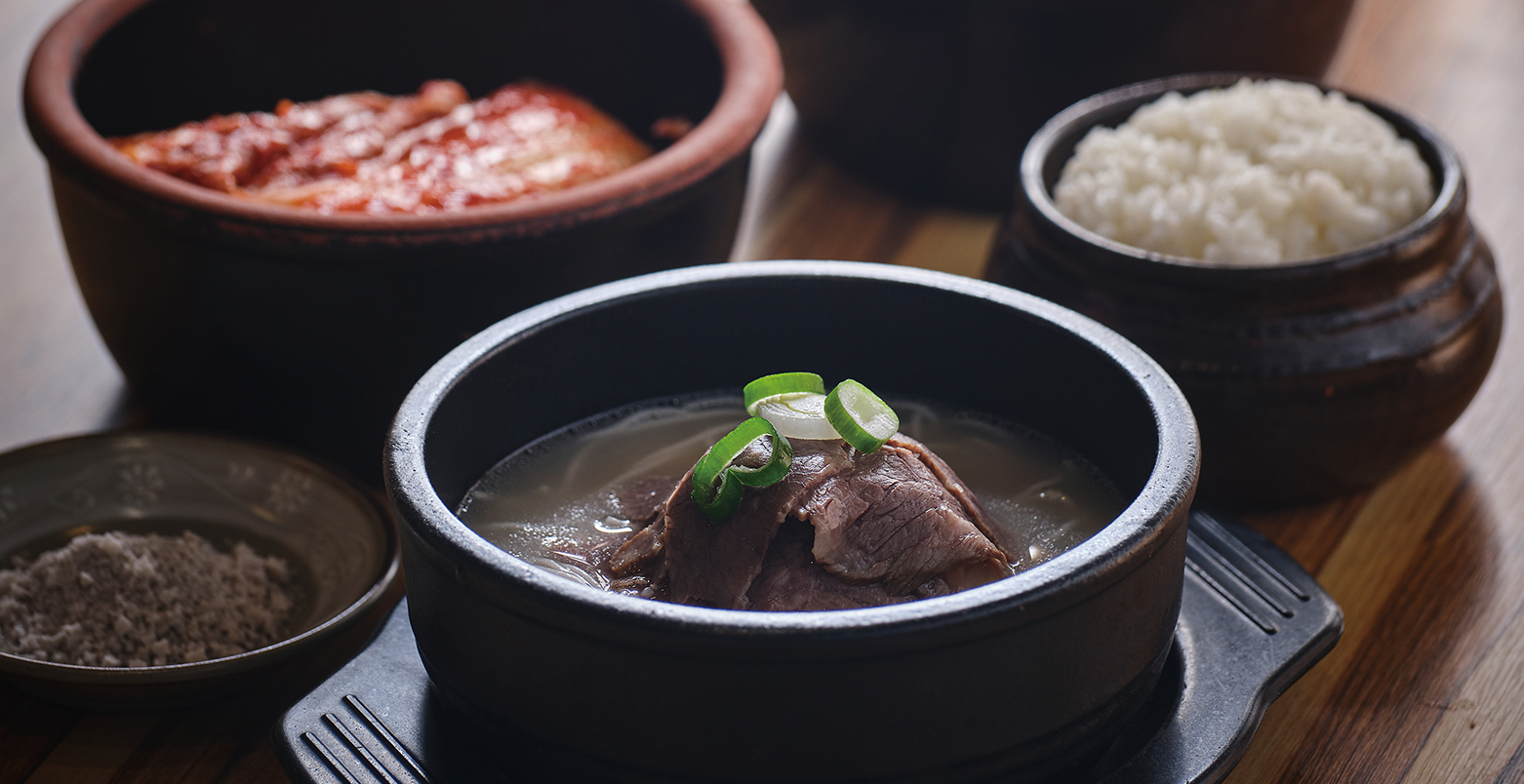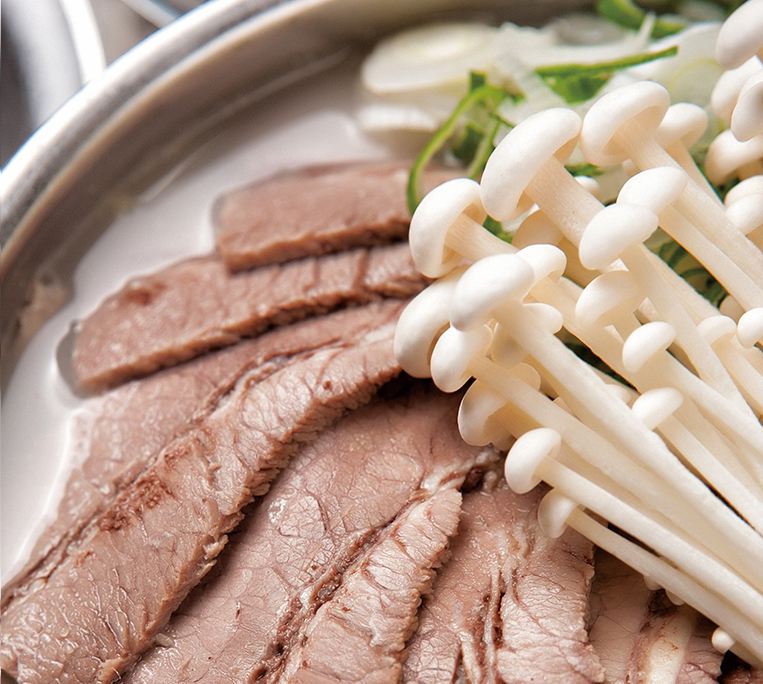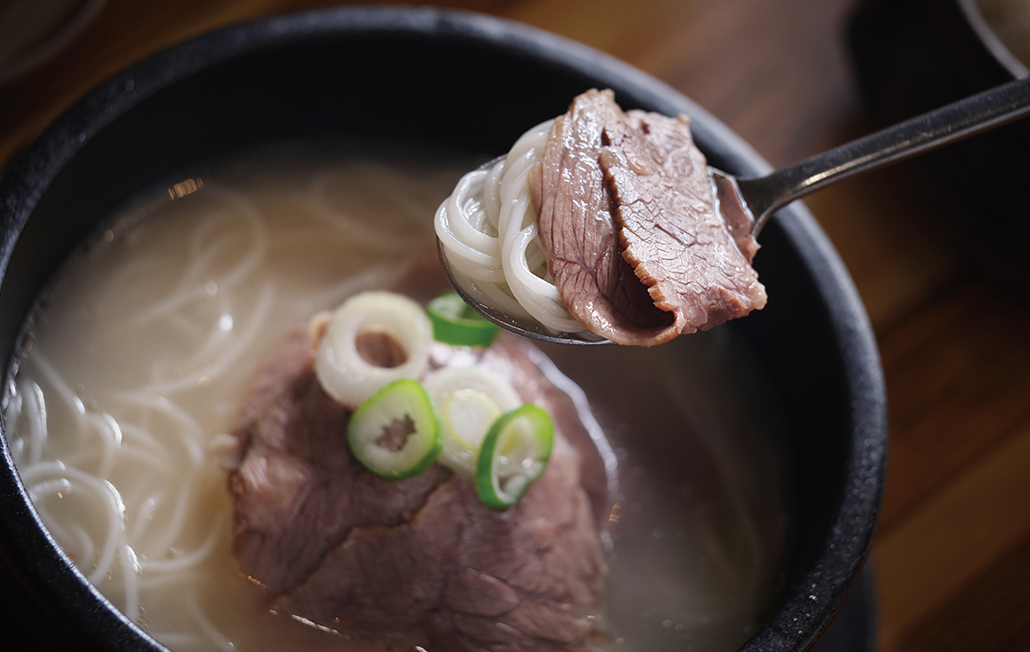
Contents










Local Taste · Written by Yoon Sui Photographed by Studio Kenn
Soup-er Dish
Seolleongtang
The popular seolleongtang (beef bone soup) is not just great for satiating hunger but also famous for boosting energy.
The government’s previous policy promoting beef production gave the dish a huge boost since
it was made from ox bones, brisket and other cuts.
Emerging as one of Seoul’s most famous specialties, seolleongtang gave rise to a host of longtime
seolleongtang restaurants in the capital’s downtown area.

Though an origin everyone can agree on is elusive, several theories attempt to explain the creation of seolleongtang, with the most popular being the seonnong theory.
During the Joseon Dynasty (1392-1910), a ceremony was held on the first day of every lunar year to pray for a rich harvest at the seonnongdan altar erected at Bojewon, a clinic from the early Joseon era, near what is now the College of Education at Seoul National University. Pigs and oxen were sacrificed in the ritual, after which beef was served as stew and pork as meat. The seonnongje ritual was so important in Joseon’s agricultural society that the king participated in it, which naturally drew a huge - and hungry - crowd. Large amounts of boiled rice and soup were cooked in large pots. The beef stew served at the ritual was called seonnongtang (tang is Korean for “soup”), and this is how the term seolleongtang is believed to have been derived.
Meticulous Preparation
Though it looks like a simple meal, seolleongtang requires many hours of preparation because the soup needs simmering through a couple of steps. Major ingredients include a cow’s head, intestine, bone, feet and knee cartilage. The ingredients are boiled for a while, taken out and rinsed to remove excess fat, and boiled again. The fat floating on top is subsequently removed for hours before a variety of spices are added to reduce the smell of fat. That is why many seolleontang restaurants are open 24 hours. Once cooked, the dish is easy to serve, and this is why it has remained popular among ordinary people in modern Korea for a long time.
Given its popularity as a dish that originated in the capital, the Seoul Metropolitan Government has designated seolleontang the first food to be included on the list of Seoul Future Heritage. Several of the city’s seolleongtang restaurants have been selected as Citizen Life Cultural Heritage as being worthy of preservation.
 Seolleongtang soup is boiled all day in a large pot with ox bones to ensure a rich flavor. © shutterstock
Seolleongtang soup is boiled all day in a large pot with ox bones to ensure a rich flavor. © shutterstock Sliced brisket meat is added to the top of the bowl. © shutterstock
Sliced brisket meat is added to the top of the bowl. © shutterstockInseparable Side Dish
Seolleongtang can be a bit too fatty and pungent because of the long hours needed to simmer cow intestine and bone. To reduce the fatty taste, diners sprinkle chopped spring onions in the stew before eating. Certain restaurants also add a generous portion of the onions in the soup before serving. An inseparable side dish for seolleongtang is kkakdugi (diced radish kimchi). To neutralize the stew’s taste and smell, pungent spices are added in the preparation process. For the same purpose, seolleongtang is served with kkakdugi as a side dish, and kkakdugi liquid can be added to the stew. In addition to reducing the taste and the distinctive aroma of seolleongtang, kkakdugi enriches the stew’s taste with its unique flavor.
Somyeon (thin noodles made of wheat flour) also goes well with seolleongtang. After the Korean War, the nation had a relative abundance of foreign wheat flour. The government recommended eating bunsik (food made from flour) amid a shortage of rice, and went as far to force restaurants serving gomtang (beef bone soup) and seolleongtang to add wheat flour noodles (over 25%) to the dishes to reduce rice demand.
Seolleongtang reflects not only Korean culinary culture but also the ups and downs of life on the Korean Peninsula. Thus the dish holds a special place in the hearts of Koreans everywhere.
 Seoul-style seolleongtang is always accompanied by kkakdugi (cubed radish) kimchi. © shutterstock
Seoul-style seolleongtang is always accompanied by kkakdugi (cubed radish) kimchi. © shutterstock A bowl of seolleongtang is garnished with cooked noodles and brisket, and rice can be added directly to the soup.
A bowl of seolleongtang is garnished with cooked noodles and brisket, and rice can be added directly to the soup.Other Articles















